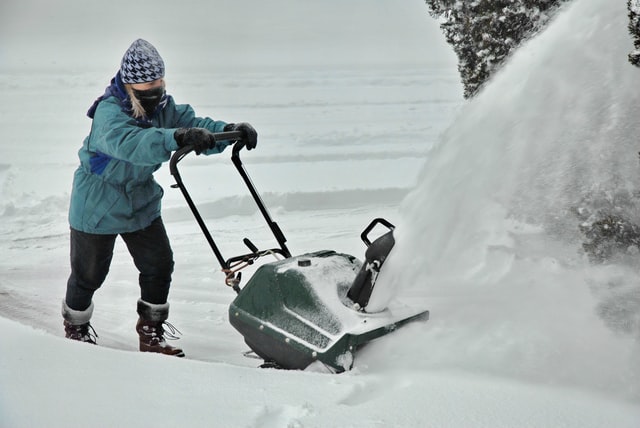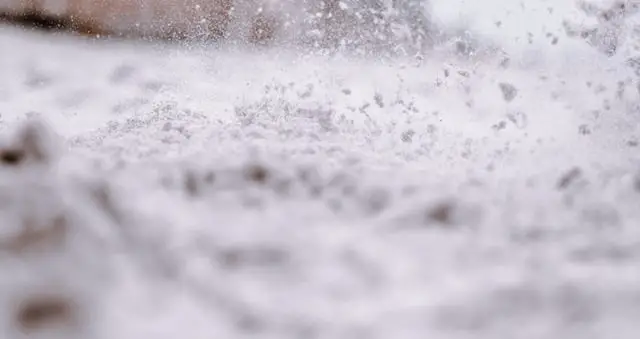Getting snow off your driveway is one part of the task of removing snow from your property. The other part of the task is to ensure your snowblower starts and runs smoothly, and the last part is to make sure the snow won’t stick on the snowblower’s chute and auger. Many of us have had such sticky snow experiences, haven’t we?
Not to bore you anyway, here are some of the best things you can do to keep the snow from sticking to your snowblower.
Contents
To Answer The Question…
There are various recommended methods of keeping snow from sticking to your snowblower. Using a nonstick snowblower spray is arguably the most effective method. This method involves spraying the nonstick sprays on the auger and chute before using the snowblower to keep the machine working smoothly without any clogs.
Think of it as applying oil to a pan to make it somewhat non-sticky.
Why does snow stick to snowblowers?
The snow’s moisture content is one of the reasons why snow sticks to your snowblower. Wet snow can clump together, unlike light, soft snow, which is somewhat the opposite. When it clumps together, it’ll stick to the body of the auger and chute as you’re pushing the snowblower through the snow. It builds up even more when you’re walking slowly to clear the snow.
Also, it’s pertinent to point out that using an underpowered snowblower to clear snow in an area known for heavy snow can cause the snowblower to get clogged.
That said…
Why is it important to keep snow from sticking to the snowblower?
Imagine having to spend the whole day clearing the snow off your property because your snowblower is clogged. Perhaps this task would have taken you less than three hours if the snowblower wasn’t clogged.
You get the point.
It’s vital to prevent the snow from sticking to the snowblower so that you can get done with the snow removal ASAP.
Well,
How do you prevent the snow from sticking to the snowblower?
As we mentioned earlier, there are many other ways to keep snow from sticking to your snowblower while you’re using it.
1. Using A Lubricant Spray
A nonstick snowblower spray will make it a tad difficult for the snow to auger and chute of your snowblower. They cost a few bucks and can last a few weeks with each use. There are also one-time sprays that you must apply with each use. We recommend the multi-use spray over the one-time spray. There are some questions about using lubricant sprays.
- Does using a nonstick snowblower spray damage the snowblower? No, using a nonstick snowblower spray will not damage your snowblower. Ensure that you spray it on the right parts. Also, make sure that the product isn’t expired yet.
- Can I use any other lubricants like vegetable oil? We don’t recommend using any other lubricant in place of the spray. Vegetable oil and other lubricants in its class can make things messy, and more snow will stick to your snowblower – more than you bargained for.
- How often should I use the spray on my snowblower? As we mentioned briefly earlier, there are two categories of nonstick snowblower spray. One type of spray can last up to four weeks, while the other can only last for each snow removing job. You should choose the one that suits your preferences. We recommend going for the long-lasting spray.
- Should I take any precautions with the spray? Yes, you should check your product manual to determine if you can use any sprays (and which ones to use). Also, ensure that the spray is kept away from children and pets, and wear protective clothing where necessary.
- Will I be able to use my snowblower immediately after spraying? There’s a stipulated drying time for a lubricant spray. Ensure that you wait a few minutes more than the specified drying time to give the lubricant spray time to dry off.
A nonstick lubricant spray does a lot of wonders, but you should also try the other steps below.

2. Manually Clearing The Chute
Some snow blowers come with a manual removal tool that helps you to clear the chute when it seems like it’s getting clogged. Please, DON” T USE YOUR HANDS/FINGERS to try and unclog the chute of your snowblower. You’ll risk amputation if your hand gets in the way of the moving parts in the chute and auger.
Always use the provided tool or find a long mop stick and use the rear end. Ensure that the snowblower is completely turned off, and make sure to wait a few minutes after turning it off to perform any cleaning tasks on the chute. (Disclaimer: We’re not responsible for any accidents that may occur)
After unclogging the snowblower, you should apply the nonstick spray on it.
Lastly,
3. Walk Faster With Your Snowblower
Honestly, we’re not sure this is the ideal way to do it, especially if you want to properly remove snow in an area properly before moving forward. Well, there’s no harm in walking fast when you’ve done the spraying technique.
Wrapping up
We hope you found this article helpful in preventing clogging in your snowblower as we approach winter. Stay safe out there, and remember to keep your hands covered adequately.
- How to Get Potatoes to Sprout Eyes: Detailed Growing Guide with 3 Options - July 31, 2023
- Weight of a Medium Potato: Revealed in Detailed Guide - July 29, 2023
- Maris Piper Potatoes: 9 Substitutes You Should Know About - July 27, 2023
Hello! I’m Jessica Zander, a garden coach and consultant based in the Boston area (zone 6b), offering virtual consultations across the country and Canada.
I’ve been passionate about gardening since the early 1990s, and in 2022, I launched You Can Do It Gardening to empower individuals to feel more confident in their gardening endeavors.
Following a 30-year career in nonprofit finance and operations, I transitioned out of that field in mid-June of 2023 due to the growing demand for coaching services. Interestingly, my years of presenting financial statements to boards and finance committees proved to be valuable experience for teaching people about gardening! I enjoy sharing skills, providing guidance and suggestions, and collaborating efficiently with clients to make significant improvements to their outdoor spaces, both small and large. I also regularly teach at the Arlington Continuing Education and Cambridge Adult Education.
My approach is direct and practical, akin to Mary Poppins, but tailored to your garden. Clients find satisfaction in saving money and taking pride in their own gardening achievements.


Add comment